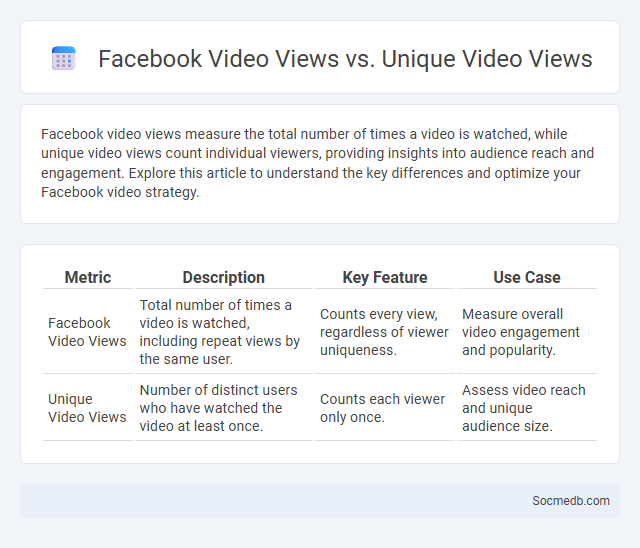
Photo illustration: Facebook Video Views vs Unique Video Views
Facebook video views measure the total number of times a video is watched, while unique video views count individual viewers, providing insights into audience reach and engagement. Explore this article to understand the key differences and optimize your Facebook video strategy.
Table of Comparison
| Metric | Description | Key Feature | Use Case |
|---|---|---|---|
| Facebook Video Views | Total number of times a video is watched, including repeat views by the same user. | Counts every view, regardless of viewer uniqueness. | Measure overall video engagement and popularity. |
| Unique Video Views | Number of distinct users who have watched the video at least once. | Counts each viewer only once. | Assess video reach and unique audience size. |
Understanding Facebook Video Metrics
Facebook video metrics provide crucial insights into viewer engagement and campaign performance. Key metrics such as video views, average watch time, and audience retention help marketers gauge content effectiveness and optimize future videos. Tracking click-through rates, shares, and comments further enhances understanding of audience interaction and content reach on the platform.
What Counts as a Facebook Video View?
A Facebook video view is counted when a user watches a video for at least three seconds, indicating initial engagement with the content. Autoplayed videos that appear on your screen also contribute to the view count, regardless of whether the sound is on or off. Understanding these metrics helps you accurately gauge your video's reach and optimize your social media strategy effectively.
Defining Unique Video Views on Facebook
Unique Video Views on Facebook refer to the count of individual users who watch a video for at least three seconds. This metric helps advertisers and content creators understand the actual reach and engagement level of their video content. Tracking Unique Video Views reveals user interaction patterns, enabling optimization of video strategies for higher audience retention and conversion rates.
Facebook Video Views vs Unique Video Views: Key Differences
Facebook Video Views count every time a video is watched for at least three seconds, making it a measure of total engagement without considering repeat views by the same user. Unique Video Views track the number of individual users who watch a video for at least three seconds, providing insights into the actual audience reach. Analyzing both metrics together helps marketers understand content performance by distinguishing between broad exposure and unique viewer interest.
The Concept of “Video View” on Facebook
The concept of a "video view" on Facebook is defined by the platform as a user playing a video for at least three seconds, allowing advertisers and content creators to gauge initial engagement levels. Facebook's algorithm prioritizes videos with higher view counts and longer watch times, optimizing content delivery in News Feeds and increasing organic reach. Metrics such as total views, average watch time, and viewer demographics provide critical insights for refining video marketing strategies and enhancing audience targeting.
How Facebook Counts Video Views
Facebook counts video views by measuring the time a user spends watching a video, with the primary threshold set at three seconds to register a view. This metric includes autoplay videos and accounts for views from both on-feed and in-stream placements. Facebook's algorithm distinguishes between partial views and average watch time to optimize video performance analytics for advertisers and content creators.
Why Unique Video Views Matter
Unique video views are crucial for measuring the true reach and engagement of social media content, as they represent the actual number of individual viewers rather than repeated views by the same user. This metric helps marketers understand audience size, optimize content strategies, and attribute return on investment more accurately. Brands rely on unique views to gauge campaign effectiveness and enhance targeted advertising efforts on platforms like YouTube, Instagram, and TikTok.
Maximizing Engagement With Facebook Video Metrics
Analyzing Facebook video metrics such as view count, average watch time, and engagement rate enables you to maximize your content's impact. Tracking audience retention and click-through rates provides insights into which videos resonate most with your target demographic, allowing for strategic adjustments. Optimizing these metrics ensures your videos foster higher interaction and boost overall social media presence.
Interpreting Your Facebook Video Analytics
Interpreting your Facebook video analytics involves analyzing key metrics such as watch time, audience retention, and engagement rates to understand how viewers interact with your content. Focus on which parts of the video hold viewers' attention and where drop-offs occur to optimize future video content for higher retention and better reach. You can leverage these insights to tailor your social media strategy, improving video performance and audience growth on Facebook.
Best Practices for Tracking Facebook Video Performance
Tracking Facebook video performance requires utilizing Facebook Insights to monitor key metrics such as video views, average watch time, and audience retention rates. Implementing UTM parameters on video links enhances tracking accuracy through Google Analytics, enabling detailed analysis of traffic sources and user engagement. Regularly reviewing engagement metrics like shares, comments, and click-through rates helps optimize content strategy for improved audience interaction and reach.
 socmedb.com
socmedb.com